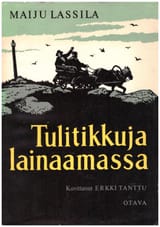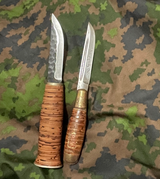Anonymous
8/22/2025, 6:50:00 PM
No.64156763
>>64156813
>>64156892
>>64156938
>>64157199
>>64157416
>>64157510
>>64157761
>>64158339
>>64161044
Minor, half-forgotten trivia.
Hey, Finnfag here.
I'd like to point out a very minor detail about certain Finnish puukkos that is not widely known. This is something I learned from my father.
Pic related shows Eastern Finland -style Ilves (bobcat) puukko. Notice how the tip of the blade curves strongly upwards before coming to the point, creating almost a "notch" in the blade. That's not an accident. That "notch" is there by design. Although that notch is not present in all puukkos, it is relatively prominent in the older style Eastern Finland Puukkos.
It's there to catch the handle of the coffee pot, as you pick it up from a fireplace. (I'll post a pic of what I mean) Those coffee pots get hot, you know? Sure, you might use a pot-mitten or just gloves or something to pick it up, but that's what the notch in the knife is there for. If you have a knife that does not have that notch, you can still pick the coffee pot from the fire, but there is always a risk that it slips and ...well, you might spill your coffee. Which is a terrible shame upon you and your house. With that notch, the coffee pot will stay securely on it as you lift it up and set it aside to cool.
Finns take their coffee very seriously, so people in Eastern Finland in particular (different regions of finland have different traditions for Puukko making, a lot of it is task-oriented so geography affects the design) have valued the ability to safely take a coffee pot from the campfire without spilling it to such a degree that they have implemented this into the design of their knives.
I haven't seen such design in more modern knives, which is a shame. And maybe because of this, not many people know that THAT was the purpose why some of the older blades had a strongly upwards-curving blade-tips. It was to hold the coffee pot.
I hope that this minor piece of woodscraft history will not be lost, as the modern world changes the shape and function of the blades.
I'd like to point out a very minor detail about certain Finnish puukkos that is not widely known. This is something I learned from my father.
Pic related shows Eastern Finland -style Ilves (bobcat) puukko. Notice how the tip of the blade curves strongly upwards before coming to the point, creating almost a "notch" in the blade. That's not an accident. That "notch" is there by design. Although that notch is not present in all puukkos, it is relatively prominent in the older style Eastern Finland Puukkos.
It's there to catch the handle of the coffee pot, as you pick it up from a fireplace. (I'll post a pic of what I mean) Those coffee pots get hot, you know? Sure, you might use a pot-mitten or just gloves or something to pick it up, but that's what the notch in the knife is there for. If you have a knife that does not have that notch, you can still pick the coffee pot from the fire, but there is always a risk that it slips and ...well, you might spill your coffee. Which is a terrible shame upon you and your house. With that notch, the coffee pot will stay securely on it as you lift it up and set it aside to cool.
Finns take their coffee very seriously, so people in Eastern Finland in particular (different regions of finland have different traditions for Puukko making, a lot of it is task-oriented so geography affects the design) have valued the ability to safely take a coffee pot from the campfire without spilling it to such a degree that they have implemented this into the design of their knives.
I haven't seen such design in more modern knives, which is a shame. And maybe because of this, not many people know that THAT was the purpose why some of the older blades had a strongly upwards-curving blade-tips. It was to hold the coffee pot.
I hope that this minor piece of woodscraft history will not be lost, as the modern world changes the shape and function of the blades.










